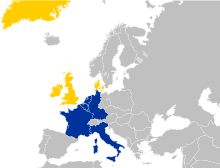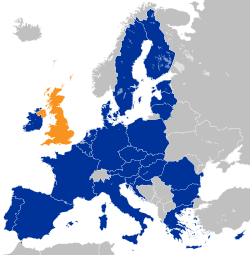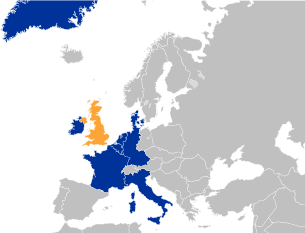1973 enlargement of the European Communities
The 1973 enlargement of the European Communities was the first enlargement of the European Communities (EC), now the European Union (EU). Denmark, Ireland and the United Kingdom (UK) acceded to the EC on 1 January 1973. Gibraltar and Greenland also joined the EC as part of the United Kingdom and Denmark respectively, but the Danish Faroe Islands, the other British Overseas Territories and the Crown dependencies of the United Kingdom did not join the EC.

| Part of a series of articles on | ||||||||||
| British membership of the European Union | ||||||||||
|---|---|---|---|---|---|---|---|---|---|---|
 | ||||||||||
|
Treaty amendments
|
||||||||||
|
|
||||||||||
|
Officials and bodies |
||||||||||
|
| ||||||||||
Ireland and Denmark both held referenda in 1972 in May and October respectively, and the United Kingdom held a referendum in 1975, on membership of the EC, all which approved membership of the EC. Norway planned to accede, but this was rejected in a referendum held in September 1972. In 1992 Norway again applied to join, but voters again rejected the proposal in a 1994 referendum.
Greenland later withdrew from the EC on 1 January 1985 after a referendum in 1982. This was followed by the United Kingdom holding a referendum in 2016 on membership which resulted in the United Kingdom voting to leave the now EU.
Background
The United Kingdom was recovering from the Second World War and Ireland remained economically dependent on the latter, which represented nearly 75% of its exports and this was codified in the Anglo-Irish Free trade agreement of 1966.[1]
In 1960 the European Free Trade Association (EFTA) was established and was formed by Austria, Denmark, Norway, Portugal, Sweden, Switzerland and the United Kingdom. These countries were often referred to as the Outer Seven, as opposed to the Inner Six of the founding members of the European Community (EC).[2] The EFTA was founded by a convention known as the Stockholm Convention in 1960, with the aim of liberalisation of trade in goods amongst its member states. On 31 July 1961 the United Kingdom,[3] Ireland[4] and Denmark[5] applied to join the EC. In 1963, after negotiations,[6] France vetoed the United Kingdom's application because of the aversion of Charles de Gaulle to the UK,[4] which he considered a "trojan horse" for the United States.[1] De Gaulle resigned the French presidency in 1969.[7][8] In the 1970s, the EFTA states concluded free trade agreements with the EC.[9]
Impact
| Member countries | Population | Area (km²) | GDP (billion US$) |
GDP per capita (US$) |
Languages |
|---|---|---|---|---|---|
| 5,021,861 | 2,209,180 | 70.032 | $59,928 | Danish | |
| 3,073,200 | 70,273 | 21.103 | $39,638 | English, Irish | |
| 56,210,000 | 244,820 | 675.941 | $36,728 | English | |
| Accession countries | 64,305,061 | 2,524,273 | 767.076 | 11,929 | 3 |
| Existing members (1973) | 192,457,106 | 1,299,536 | 2,381,396 | 12,374 | 4 |
| EC9 (1973) | 256,762,167 (+33.41%) |
3,465,633 (+266.68%) |
3,148.472 (+32.21%) |
12,262 (−0.91%) |
7 |
See also
References
- "1er élargissement de la CEE (1er Janvier 1973)".
- "Finland: Now, the Seven and a Half". TIME. 7 April 1961. Retrieved 18 July 2009.
- "Address given by Harold Macmillan on the United Kingdom's application for membership to the EC" (PDF). Le Centre Virtuel de la Connaissance sur l'Europe. 31 July 1961.
- "Ireland in the EU – Joining the European Community". European Union.
- "A timeline of the EU". BBC News.
- "Britain's EU membership: New insight from economic history". VOX, CEPR’s Policy Portal.
- "Déclaration du Conseil constitutionnel suite à la démission du Général de Gaulle, Président de la République". Constitutional Council of France. 1969. Archived from the original on 4 December 2008.
- "Press Release re Resignation". Fondation Charles de Gaulle. 2008. Archived from the original on 2008-11-18. Retrieved 2016-05-08.
- "The European Free Trade Association". European Free Trade Association. Retrieved 8 May 2016.
